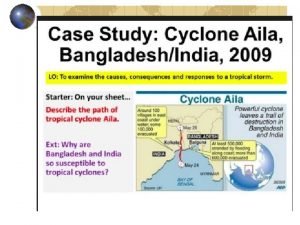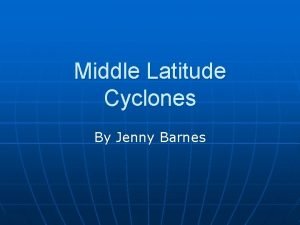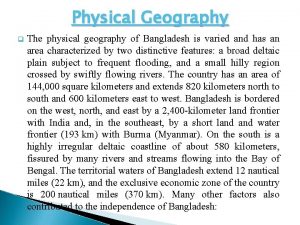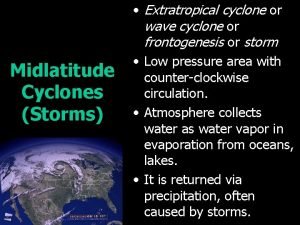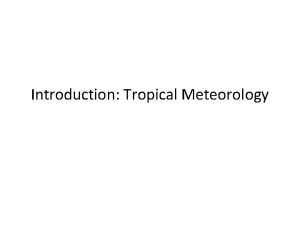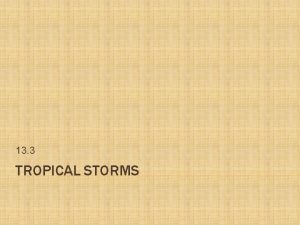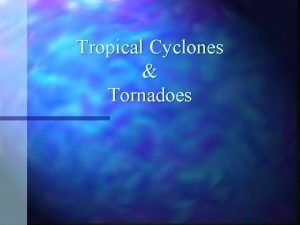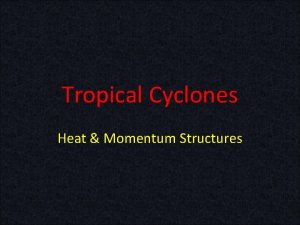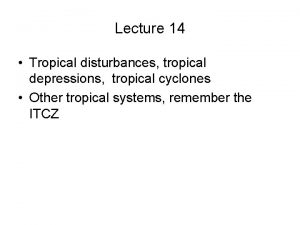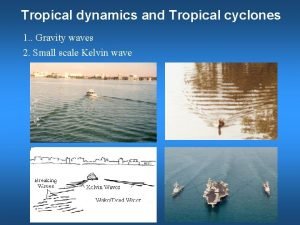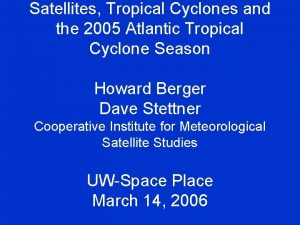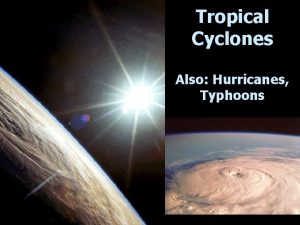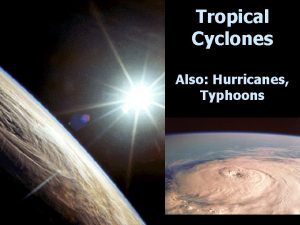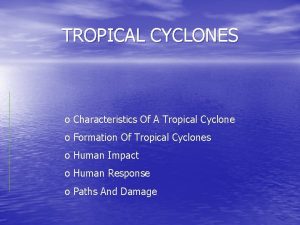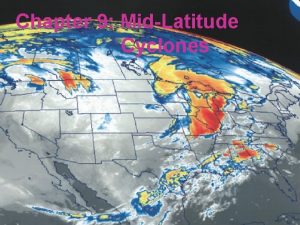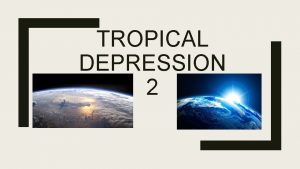TROPICAL CYCLONES Introduction Relatively small intensely developed low













- Slides: 13

TROPICAL CYCLONES

Introduction • Relatively small, intensely developed low pressure cell that usually occurs over warm oceans. • Diameter-2000 km • Characterized by a warm centre, very steep pressure gradients and strong cyclonic winds • Speed less than 60 km/h-tropical depression • Speed ranges between 60 and 110 km/h-tropical cyclones

FORMATION • Developing tropical cyclone gather heat and energy through contact with warm ocean waters-5° and 20° North and South • Addition of moisture by evaporation of sea water from the sea surface powers them like giant heat engine • A wind pattern near the ocean surface that spirals air without inward


Characteristics of tropical cyclone

Structure of the storm centre • Centre or eye- calm, warm • Eye-extremely warm-as much as 10°C • Near sea surface air has same temp through out the storm • Wall of cloud(mainly cumulonimbus) rings the edge of the eye from sea level to heights of over 15 km • Ring of the cloud-eye wall-most violent activity

Eye of the tropical cyclone

STRUCTURE OF TROPICAL CYCLONE

Hurricane warning • Issued when a hurricane with sustained winds of 74 mph or higher is expected in a specified coastal area in 24 h or less • Maritime flags-two square red flags with a black square in the middle of each • Intensity or track of a forecast cyclone is uncertain-maritime flags-two square red flags with a black square in the middle of only one of them

Effects of tropical cyclone • Destructive effects-heavy rain, strong wind, large storm surges, landfall and tornadoes • Remove forest canopy, change the landscape • Mudslides and landslides in mountainous areas • Plantations are leveled up, big trees are uprooted, settlements destroyedlose of life • Transportation and communication infrastructure • Standing water –spread of disease • Damage/destroy vehicles, buildings, bridges, overpasses and roads

Effects of tropical cyclones

World tropical cyclones • Northern hemisphere-August-October • South of the equator-February-March • Caribbean and South China sea-more affected • Indian Ocean-northeast monsoon • Bangladesh and eastern coast of India-Andra and Orissa-heavy damage every year

THANK YOU
 Global distribution of hurricanes
Global distribution of hurricanes What are middle latitude cyclones
What are middle latitude cyclones Physiography of bangladesh
Physiography of bangladesh Mid latitude cyclones characteristics
Mid latitude cyclones characteristics What are middle-latitude cyclones?
What are middle-latitude cyclones? Mid = (low + high) / 2
Mid = (low + high) / 2 Director communication style
Director communication style High precision vs high accuracy
High precision vs high accuracy Low voltage hazards
Low voltage hazards High vs low small bowel obstruction
High vs low small bowel obstruction Introduction to tropical meteorology
Introduction to tropical meteorology Introduction to tropical meteorology
Introduction to tropical meteorology Mike mozer
Mike mozer Introduction to low voltage systems
Introduction to low voltage systems
